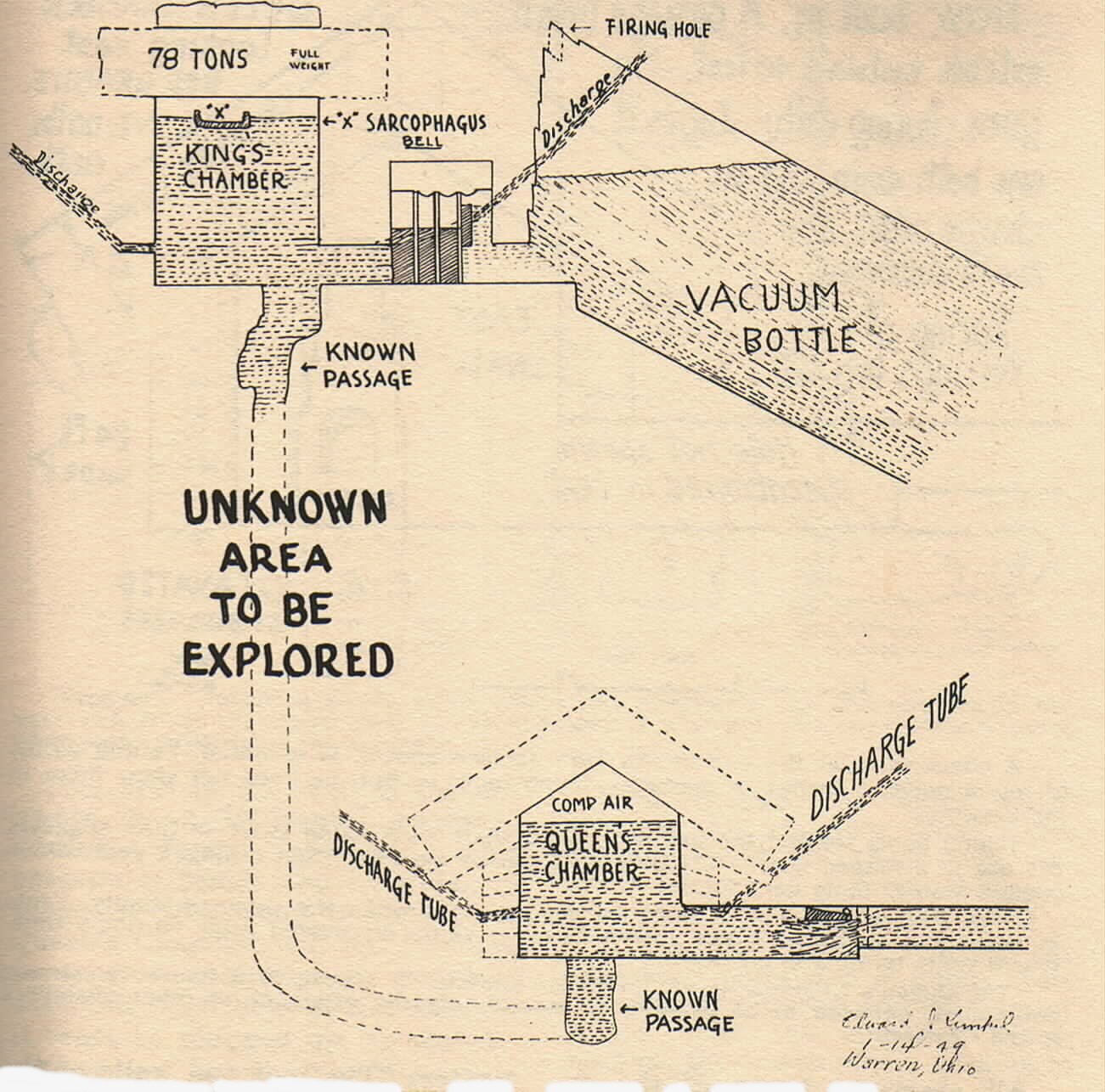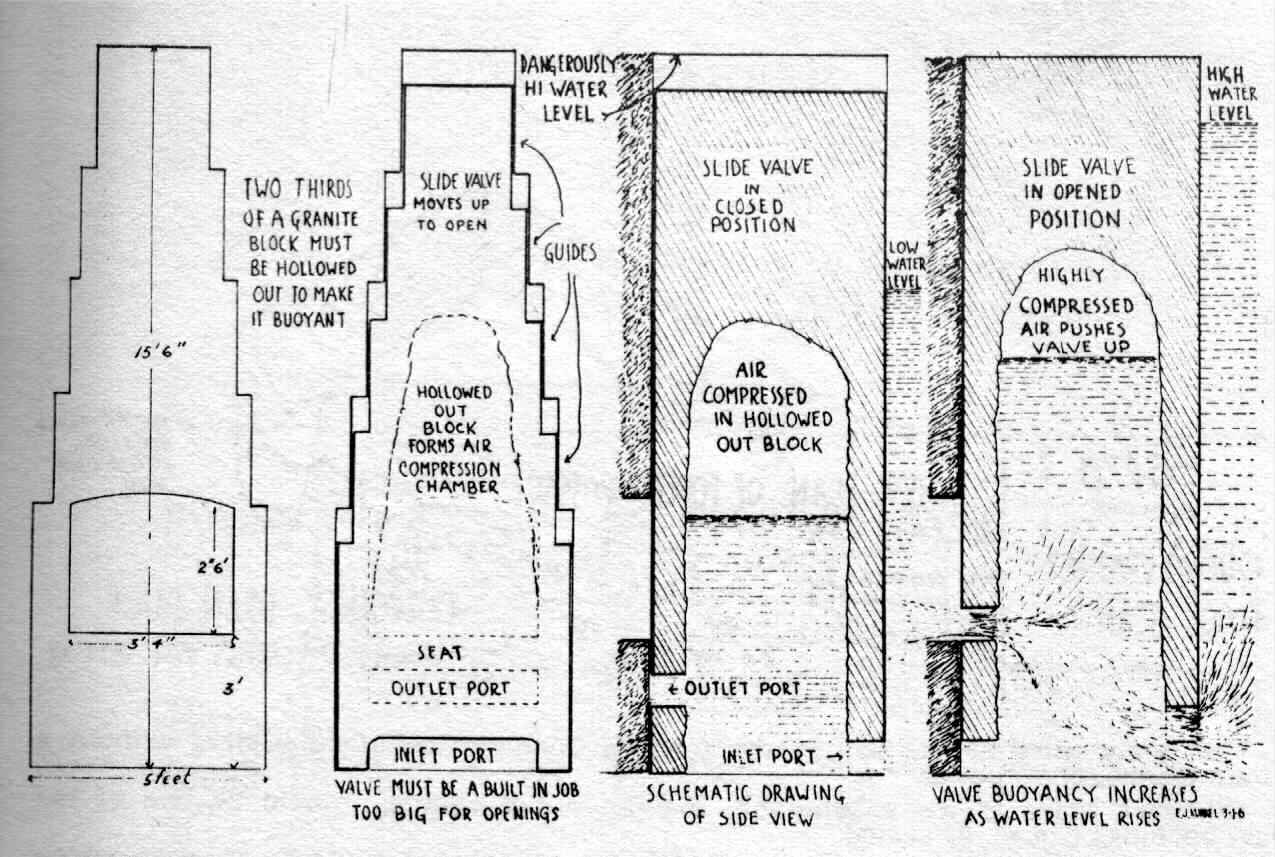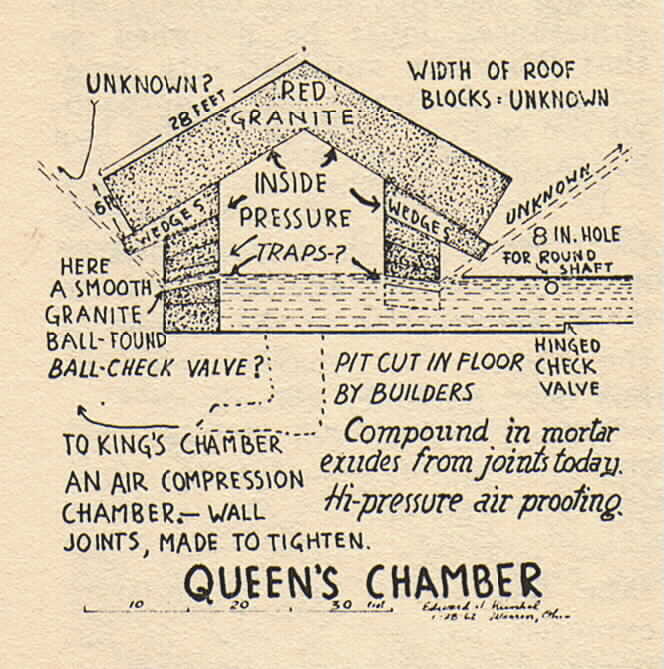

How the Great Pyramid
At Giza was built, and Why!
 Queen's Chamber
Queen's Chamber 

The King's and Queen's Chamber work in conjunction with each other.
In terms of the water flow these two chambers are in series. The
smaller Queen's chamber is first while the larger King's Chamber is second.
This arrangement of progressively larger chambers can also be found in
marine steam engines. Marine steam engines often have THREE chambers
in series. The smallest one first then the next larger and then the
largest last. This arrangement used in both marine engines and the
Great Pyramid makes the system much more efficient.
Below are a few excerpts from the book Pharaoh's Pump.
 The interior of the Great Pyramid, is perhaps the strangest ever built
by Man. It consists of two diagonal tubes, one below the ground cut
in the solid limestone, and the other above the ground made of ponderous
masonry. Each diagonal has an air compression chamber at the bottom
of it. The lower chamber in the solid rock, is a cavernous room of
very unusual shape, while the upper chamber, which is called the Queen’s
Chamber is made of enormous slabs. The blocks that compose the north
and south wall are wedge-shaped, with the thickest part of the wedge to
the inside. “It has a pointed roof of great blocks of stone, inclined
upwards and meeting in the middle.” (EB9) This chamber is designed
to withstand pressure from within. Inside pressure will tighten up
the wedge-shaped blocks that compose the walls.
The interior of the Great Pyramid, is perhaps the strangest ever built
by Man. It consists of two diagonal tubes, one below the ground cut
in the solid limestone, and the other above the ground made of ponderous
masonry. Each diagonal has an air compression chamber at the bottom
of it. The lower chamber in the solid rock, is a cavernous room of
very unusual shape, while the upper chamber, which is called the Queen’s
Chamber is made of enormous slabs. The blocks that compose the north
and south wall are wedge-shaped, with the thickest part of the wedge to
the inside. “It has a pointed roof of great blocks of stone, inclined
upwards and meeting in the middle.” (EB9) This chamber is designed
to withstand pressure from within. Inside pressure will tighten up
the wedge-shaped blocks that compose the walls.
All observers write of the exquisite precision cutting of the
blocks which compose the interior. Thousands of tourists have searched
for flaws in the joints, but no luck. Flawless fitting of the joints, is
the crux of this hypothesis.
 Problem: - invent a safety valve, which will effectively seal the
opening in the east wall when the water level in the chamber is low; but
will automatically open, when water level nears the ceiling.
Problem: - invent a safety valve, which will effectively seal the
opening in the east wall when the water level in the chamber is low; but
will automatically open, when water level nears the ceiling.
— One tiny air leak; and , as a pump it will not function, at
all.
Therefore; it is imperative that all the blocks be precision
cut, and precision fit. — No shoddy workmanship here.
Here in the Queen’s Chamber, the builders took further precautions
against an air leak. They mixed in the mortar, an indefinable sparry
substance; which; to this day, exudes from the joints and jams the fissures.
Regarding this substance Smythe writes; “The roof and walls of
the Queen’s Chamber are covered to the thickness often a quarter or even
half an inch with a coating of hard saline encrustation, almost stony sometimes
in external appearance; sparry excrescences. Colonel Vyse calls the
substance, “filling accidental fissures in the stone, and still exuding
or growing.” LAGP
In the east wall of the Queen’s Chamber is a structural formation,
called the Niche. It is recessed in the wall to a depth of four feet.
In design, it resembles a modernistic a la Hollywood fireplace; with the
hearth about 30 inches above the floor.
The opening is 40 by 30 inches. The top is arched.
The sides are vertical. The bottom is flat. — No chimney.
This hole in the wall is the entrance to a horizontal passage;
labeled “forced passage’. This passage is rough and irregular in
shape. — One thing for sure; the Queen’s Chamber will not function as a
ram compression chamber, with this open hole in the wall. — It must be
plugged up, or sealed.
It is my belief, that the name “forced passage” is a misnomer.
— I believe, that the forced passage is a drain duct for the queen’s Chamber.
I believe that the hole in the wall; and the forced passage are
part of the original structure. — I believe, that the Niche housed a SAFETY
VALVE which could be classified as a buoyant SLIDE VALVE. — I believe,
that the safety-valve opened automatically, when the water level in the
Queen’s Chamber rose dangerously near the ceiling.
A physical booga-boo plagued the ancient Engineers. This
booga-boo assumed the guise of an ogre and took on the form of air loss
in water. A loss, due to solubility of air in water. A degree
of solubility, which increased with air pressure and turbulence.
Even though, the water which entered this chamber was super-saturated
with air, there was constant danger of a diminishing air cushion.
If the air cushion reached the vanishing point and a pump cycle
occurred; the incompressible water would blow the chamber apart, because
there was no air cushion to absorb the shock.
Therefore, a safety-valve, which became buoyant under certain
circumstances must be designed so that the valve automatically opened,
when the water level approached the ceiling. — Such a valve is a hydraulic
MUST.
In the floor of the Queen’s Chamber is found, “a great quarry
hole,” which a passage leading from it, in the direction of the bottom
of the duct. This quarry hole too, has been partially excavated.
Native tourist guides say, that the duct and the quarry hole,
are one and the same passage. For some unknown reason, this passage
has never been completely explored, perhaps because, no importance could
be attached to it.
 The safety valve mechanism in the Queen’s Chamber would be useless without
a drain means, or an outlet.
The safety valve mechanism in the Queen’s Chamber would be useless without
a drain means, or an outlet.
This fact, leads to the assumption, that an outlet opening, would
be one of the last openings closed, or sealed.
I can find no record of the above, “forced passage’ being made
by vandals, which also leads to the assumption that it was made by the
builders.
Its design is not conducive to a free flow through it. — It
is slightly curved. — Part of it is constricted. — This impedes the speed
of flow. — The south wall has a series of waved formations, like corrugated
steel sheets. — Bumps, projections and indentations, are found at numerous
spots, all of which will induce backflow and eddies.
In short; the velocity of a high head of water, flowing through
this “forced passage’ will be greatly diminished.
When the safety valve opens in the Queen’s Chamber; the pressure
against its seat is reduced by back pressure, which allows the valve to
open wide; so that water can flow freely through the valve ports
Writes Herodotus, . . . “ herein is embodied all the wonder of
physick.”
 The Queen’s Chamber is the primary compression chamber for the upper diagonal,
while the King’s Chamber is a secondary one. It is in the latter
that the discharge tubes are found.
The Queen’s Chamber is the primary compression chamber for the upper diagonal,
while the King’s Chamber is a secondary one. It is in the latter
that the discharge tubes are found.
The King and Queen’s Chambers are connected by a passage of generous
proportions, but this passage is at present filled with small rocks and
debris. This passage enters the king’s chamber under the north wall,
with its opening at floor level. It is positioned identically like
a hot air duct in a floor adjacent to a wall. It has been partially
excavated. Let’s call it the “duct.”
This is just a sampling of what the book, Pharaoh's Pump explains about
the Queen's Chamber
 Home | FAQ | Contact
| Links
Please send comments or questions regarding these web pages to
Pharaoh's Pump Foundation
Copyright © 1998 Pharaoh's Pump Foundation.
Home | FAQ | Contact
| Links
Please send comments or questions regarding these web pages to
Pharaoh's Pump Foundation
Copyright © 1998 Pharaoh's Pump Foundation.






